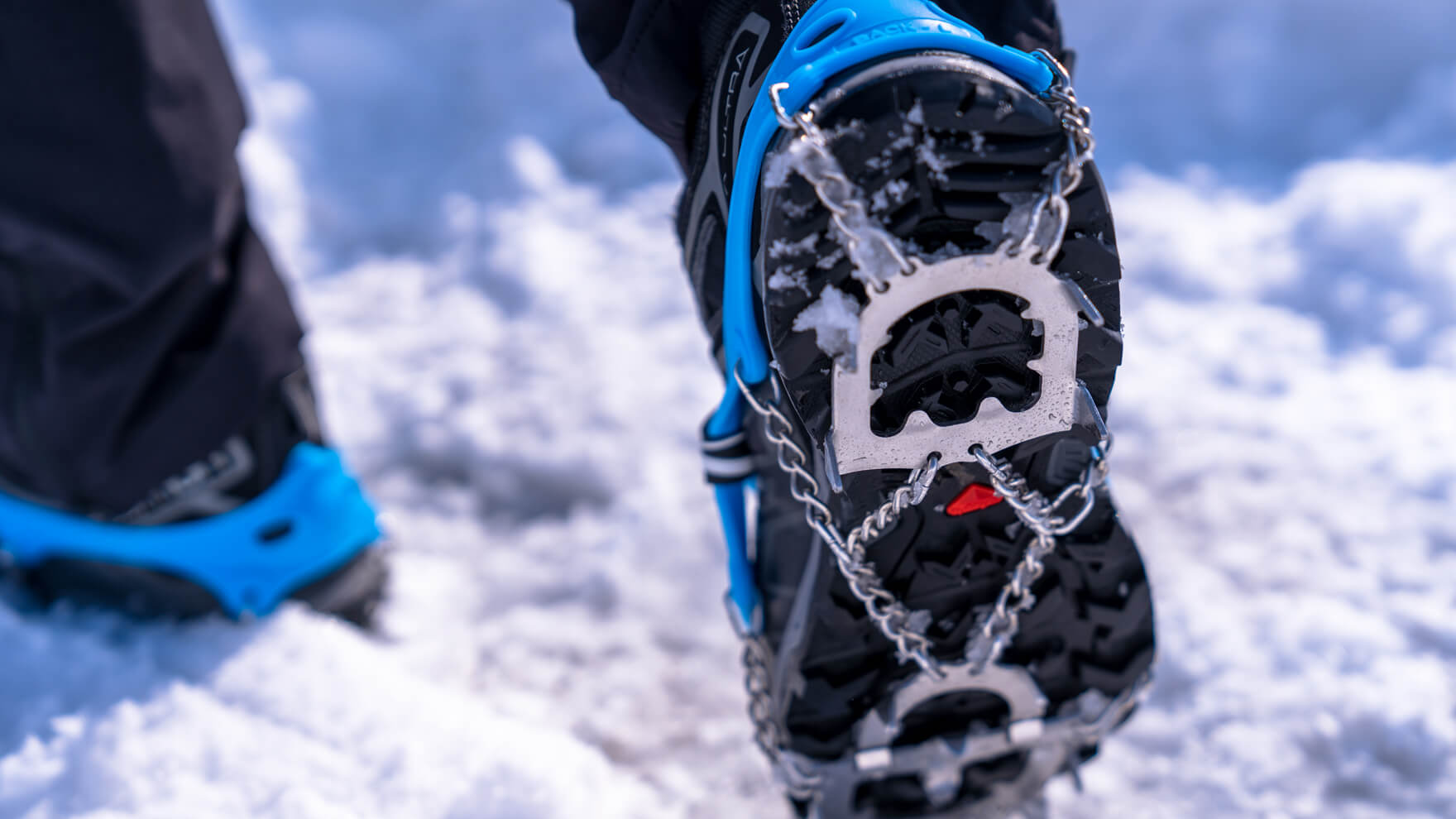
For winter hiking or everyday frozen roads. How to choose wisely a chain spike and light crampons that are safe to keep with you
It's a great thing to understand when you try it
During winter hiking, the road surface was frozen when you arrive at the trailhead, and after a little further along the trail, the snow was covered in the distance. In such cases, you should avoid hesitation to use traction devices such as chain spikes, light crampons, or crampons.
This tool does not have a clear, unified name in Japan, and is called by a variety of names, such as chain spikes, hiking crumpongs, snow spikes, snow grips, light crampons, and simple crampons, but they all have the same purpose (here we will distinguish them from authentic crampons, calling them "light crampons"). It provides a reliable grip that does not slip on snow or ice surfaces. This will stabilize walking on ice and snow, allowing for safer actions.
Light crampons are not just for hiking or trail running, but in everyday life, you can see that the use of them is wider than you might imagine, such as walking on frozen roads on snowy days and working outdoors. This makes it clear that the structure ranges from deep spikes to thin coils, and there are models with a wide variety of characteristics depending on the purpose, from models that are gentle on the daily life to products that are suitable for more demanding fields, and from those that match everyday shoes to those that can be worn with trekking boots.
So this time, we investigated various types of light crampons in the market, analyzed their performance, usage, and suitable scenes, and summarized the wisest ways to choose them from there. If you are interested, please take a look.
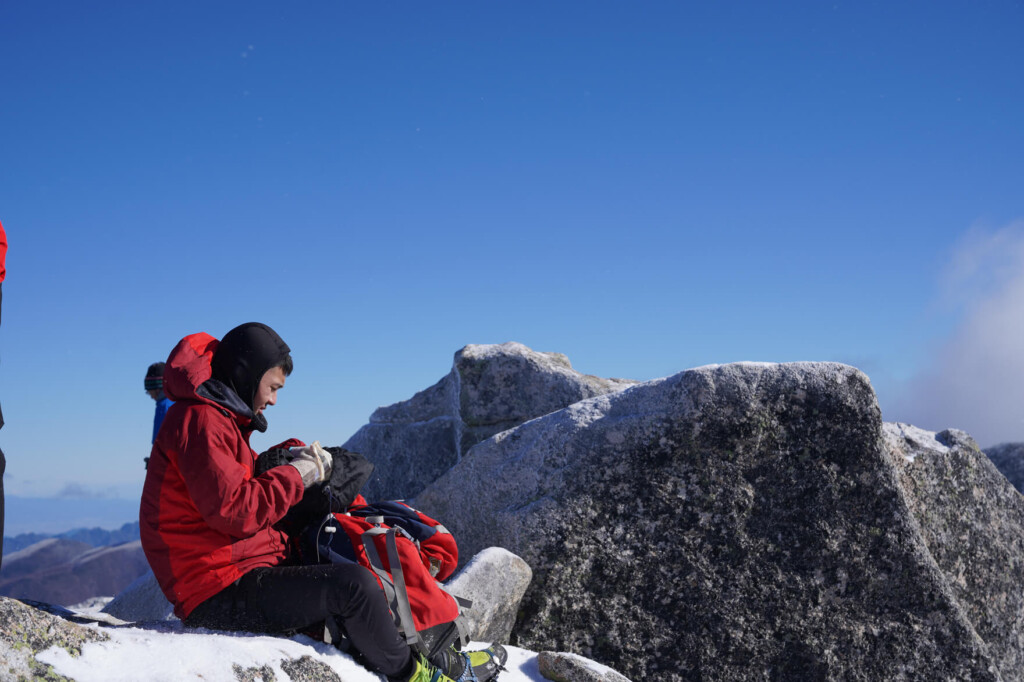
table of contents
Introduction: What is a light crampon? When do you need light crampons?
Light crampons are like snow tires or snow chains in cars. By attaching parts to the soles of your shoes to provide grip, this tool allows you to safely walk on roads that are slippery due to ice or snow.
It is said that its origins were created by European hunters and people who work in mountain work such as crystal hunters in Europe more than 100 years ago to walk glaciers*. However, due to its long evolution, in recent years, more and more variety of products have continued to be born, from affordable models for everyday use in town, light models suitable for running, models suitable for moderately steep slopes for hiking, and models suitable for walking on snowy fields.
*Source: Hotta Hiroshi, "Challenge to the Mountains" Iwanami Shinsho
What is the difference between a light crampon and a (12-pronged) crampon?
In addition to the light crampons we will introduce today, mountain climbers will know to some extent that mountain climbers have two types of tools called crampons: "crumbs," which have 12 sharp, long claws. The main difference between these two is the difference in the length of the spikes (claws) that arise from differences in use and slopes.

There is a major difference in the number and placement of teeth between crampons and light crampons.
The spikes attached to the light crampons are either a few millimeters to 1.5 cm, or a small number of long claws of 2 cm or more, at around 4 to 10. On the other hand, crampons have 12 claws that are about 3cm long and are designed to penetrate even deep ice, and their toes have protruding front claws to tug into the wall. In addition, crampons have a more solid material and a reliable binding to prevent them from breaking or loosening easily even when more force is applied, but light crampons have a flexible and simple fitting system that makes it easier to match with a wide range of shoes, including softer shoes.
When do you need light crampons? When is it useful to have?
Naturally, light crampons are lighter, more compact and easier to handle, but the penetration power to ice on slopes and walls is far greater than that of the ice. For this reason, light crampons are used on shallow snow or frozen gentle roads for glaciers and snowy trekking, while crampons are suitable for serious climbing on thick ice, rocks, tight snowy slopes and ice walls.
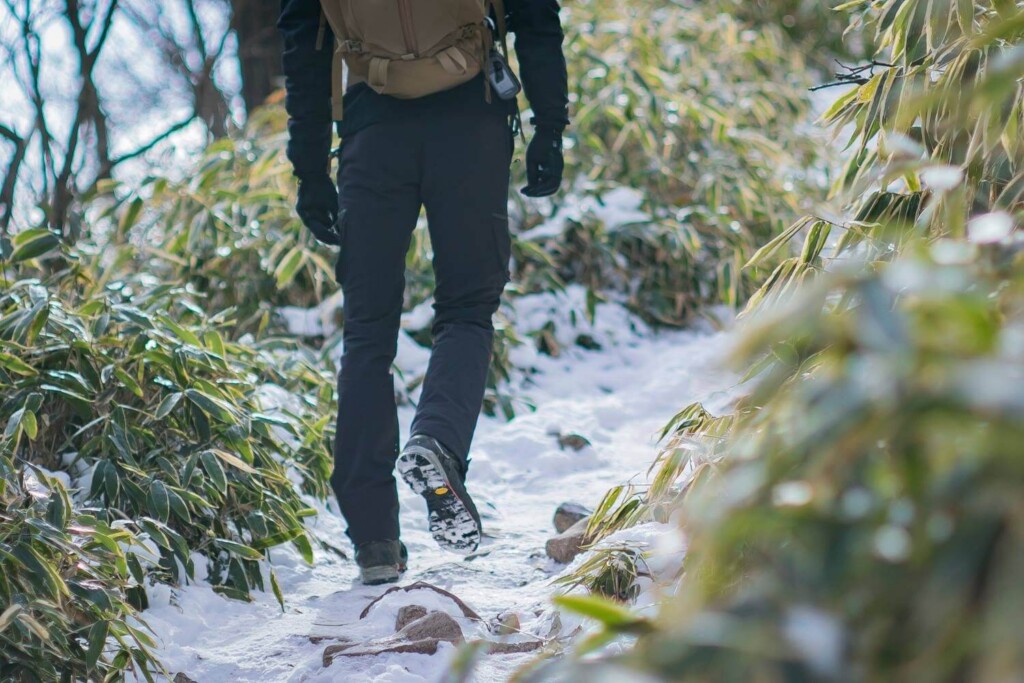
Slips are inevitable on frozen roads and trails covered in snow, no matter how serious the hiking boots are.
From my personal experience, the time when light crampons fits well is when you climb winter mountains and think, "Bringing crampons is a bit of a stretch." This means that it may be frozen on relatively flat surfaces, including low mountains that may or may not have snow, or forest roads for approaching. For example, low mountain hiking in winter. It's not like there's a mixed ice and rock area or a dangerous steep slope that's likely to cause slipping, but if there's definitely snow or freezing, light crampons are useful. It is also a good idea to wear spikes that are suitable for running around town right after snow falls.
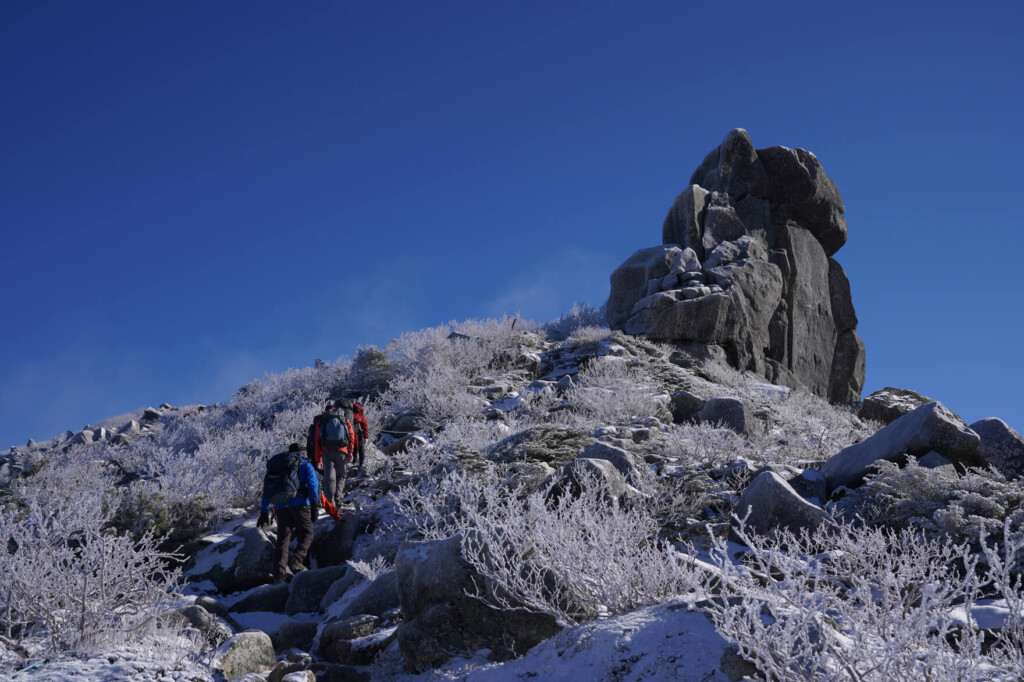
What if you're not sure which to bring, a light crampon or a crampon? In this case, even if the road is flat, you won't be able to walk with crampons, so considering that light crampons could not be used on steeper slopes, you should bring them with you in this case (of course, be used to the basic way to walk with crampons).
How to choose: 5 points to check out to choose the best light crampons
Point 1: Find out the right terrain and activities depending on the type of light crampons
Light crampons are basically effective on tight snow or frozen ice that is difficult to walk without slipping, but even though they are simply called light crampons, their characteristics, strengths and weaknesses vary greatly depending on the model. These can be roughly divided into three types depending on the purpose and the construction of the grip part optimized for the terrain you are walking in.
The first thing you need to do to choose the perfect light crampons for you is to know the characteristics and differences of these main types. Let's take a look at the characteristics of each type.
Coil type: For walking and running on frozen paved roads or flat roads in everyday life
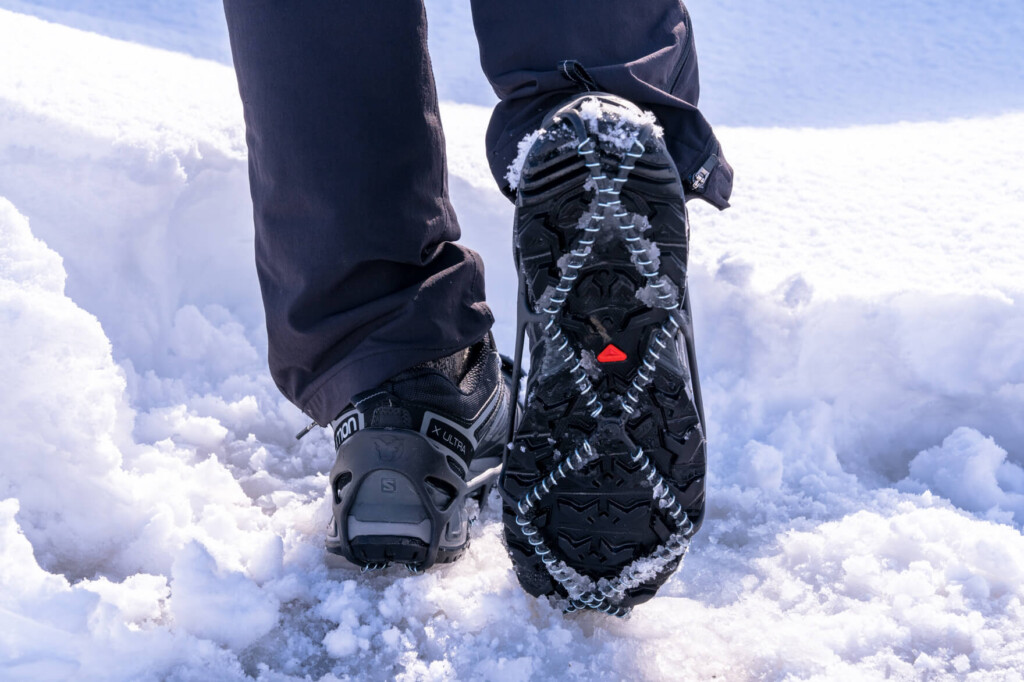
The coil-type light crampons are used by fastening them to the shoes with elastic rubber cables wrapped in wires to dig into ice and snow. , such as walking on frozen paved roads, flat forest roads, and flat roads with light snow, outdoor work such as snow removal, walking, and gentle running . If this is the case, it won't bother you even if you ride a bicycle. Most of the simplest and inexpensive models, and can be attached to almost any type of shoe or boot, but due to its somewhat unreliable strength and grip, it is not very suitable for trekking that uses roughly more hands than everyday shoes (though it's better than not).
Spike type: suitable for a wide range of occasions, from everyday use to outdoor activities
With the spike type, a sole is studded with fine studs and small pointy nails (spikes) that are attached to the shoe to secure it. The spikes are wide in size and shape, and the lightest and simplest model like the one shown in the photo below can have a pin of about 2mm attached, models that are designed to be in the same scene as the coil type above (usually everyday use or running) .
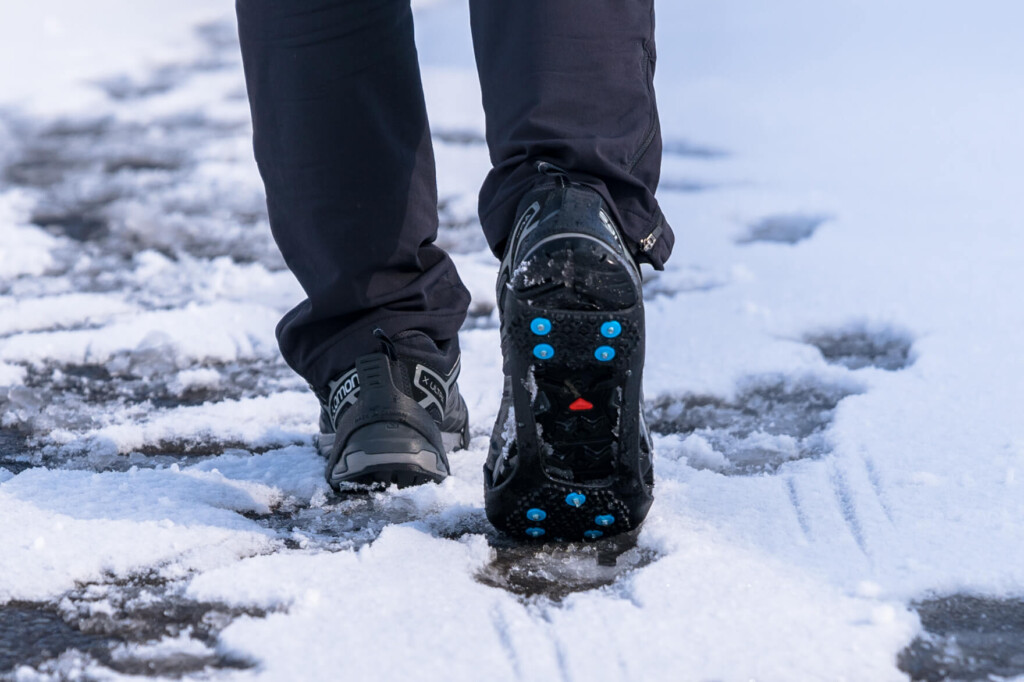
It is not noticeable and shallow, so it is useful on flat, frozen roads, but it cannot be digged into thick ice or snow, making it not suitable for hiking.
As the spikes grow, they become closer to the shape of a full-fledged crampon claw than a pin. However, the nails are clearly smaller in size, and instead they are characterized by the fact that they are scattered around the soles of the shoes (photo below).
These are more durable than coil types or stud types, and can grip even if ice and snow become stiffer and thicker, so from this point onwards you can use them for mountain climbing with peace of mind. Due to its good balance between strength and portability, this type to use for winter hiking and a variety of other outdoor activities, so each manufacturer sells many products optimized for detailed applications. Therefore, depending on the model, the size of the nails varies. The smaller the claws, the less unevenness (and lighter) is when walking on frozen or paved roads, making it more suitable for running activities (photo below).
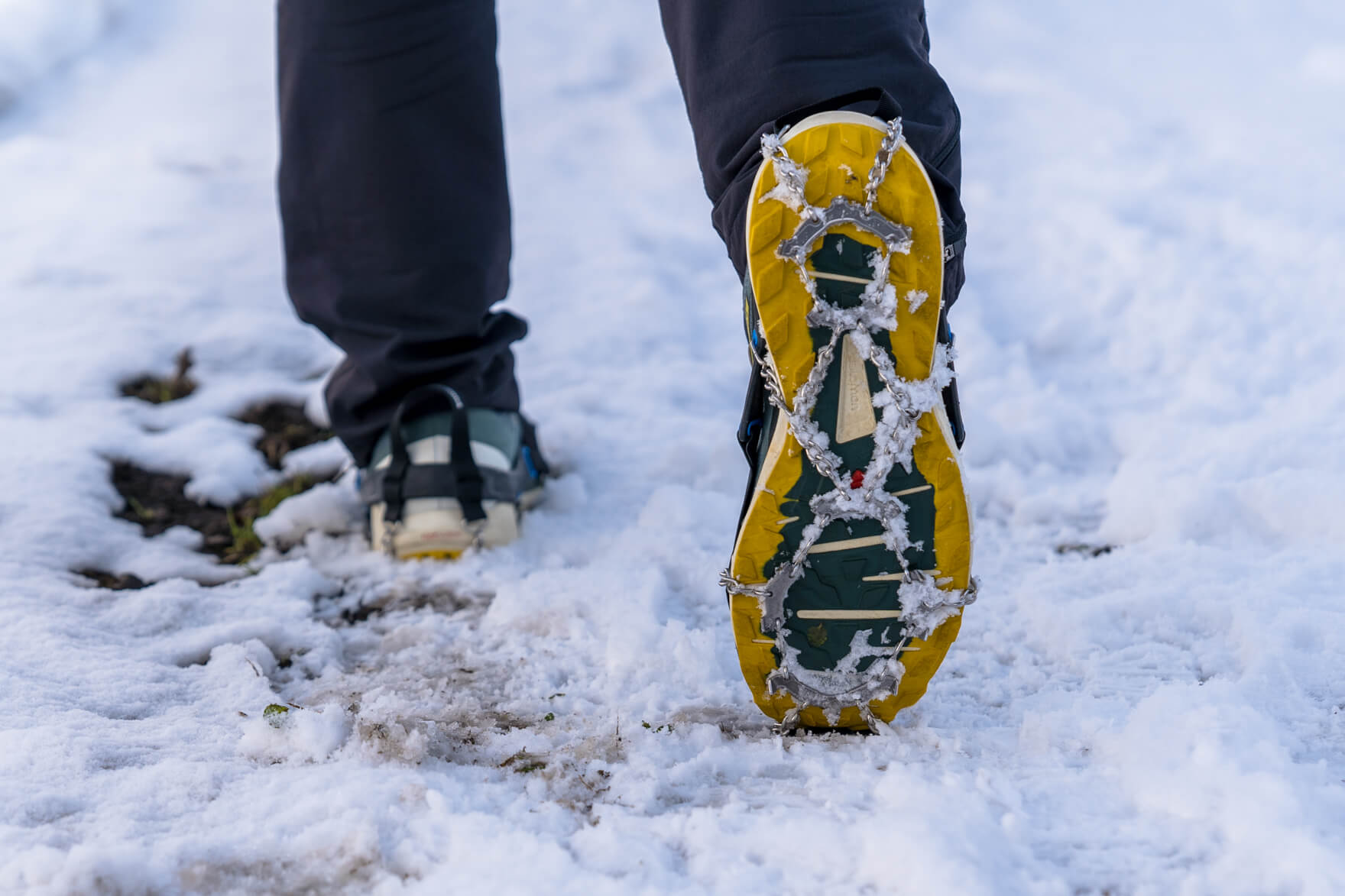
Conversely, the larger claws can be used not only on flat ground but also on more technical terrain and somewhat steep slopes , making it much more versatility (photo below). However, there is a limit to the length of the claws and it does not work very well on deep snow, steep slopes, and hard, thick ice.
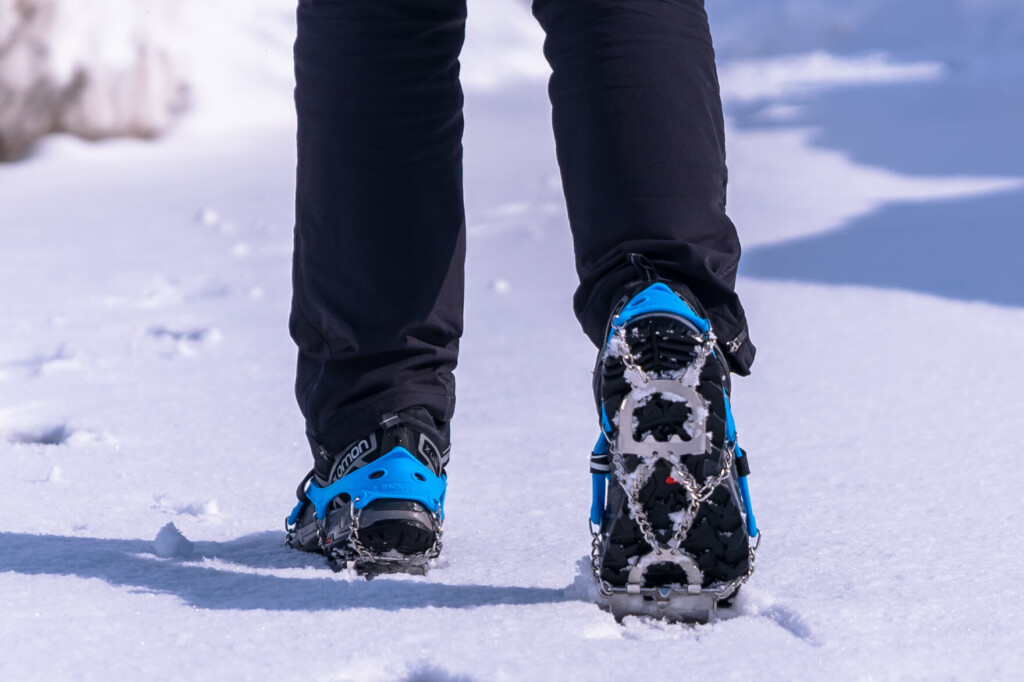
Suisen-type: For remaining snow seasons, walking around snowy fields, and mountain scenes just before the full-scale climb
Of the devices classified as light crampons, this crampons type has the longest nails.
The long nails are about 2cm or more, and have a binding that can be secured more firmly, so at first glance it's hard to tell the difference between them and authentic crampons. The big difference is the number and placement of the nails. Generally, light crampons have fewer claws, at around 4 to 10, while light crampons with four or six claws only have claws near the center of the foot. Also, even though the 8-10 models have nails placed all over their feet, the basic model is one that does not have sharp, long, front nails.
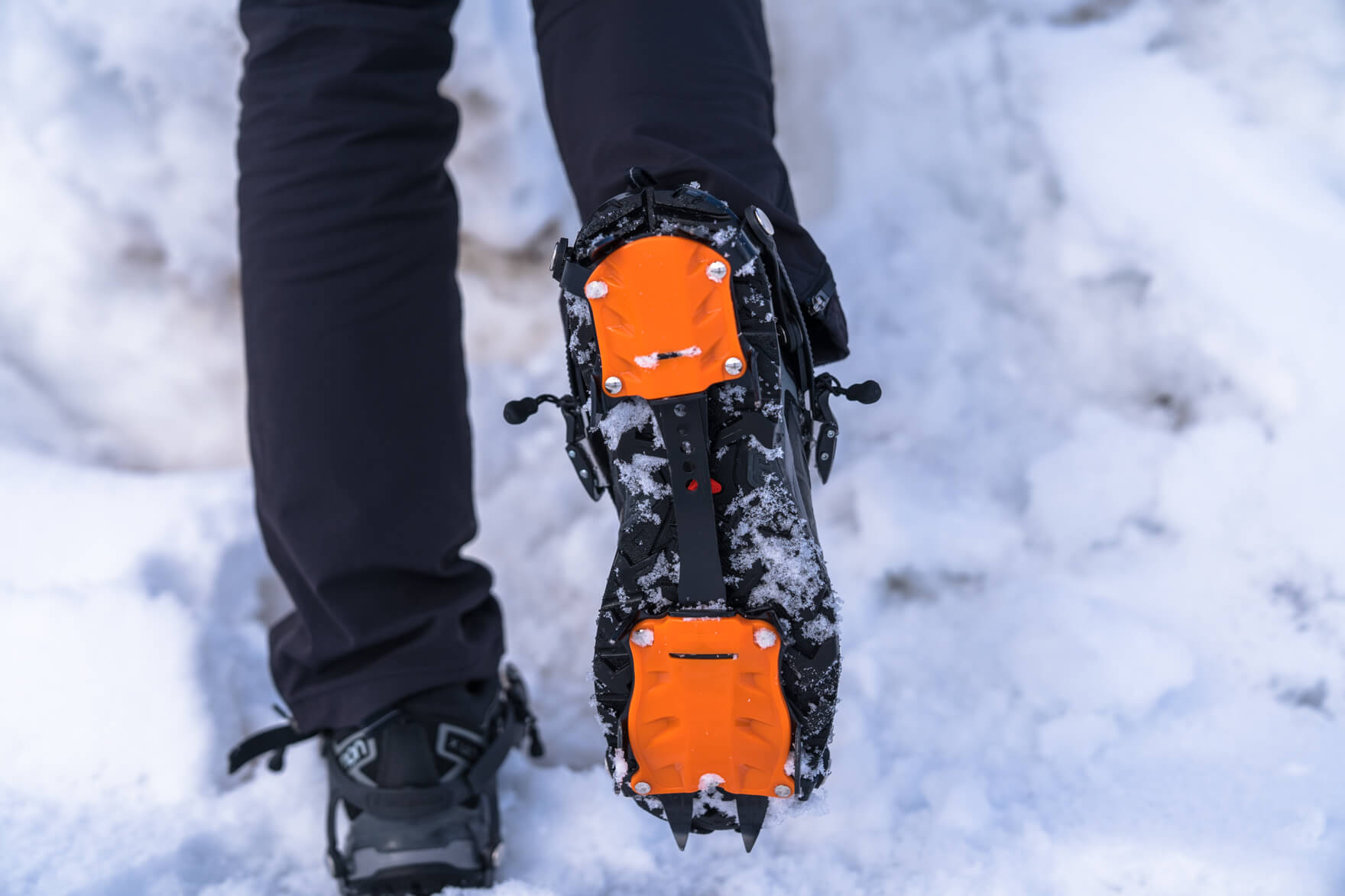
By using these long, sharp claws, the crampon type grips even harder, thicker, slippery, and steep, technical trails, making it suitable for alpine mountains during the remaining snowy season, walking on snowy fields in the summer, or routes just before a full-scale climbing snowy mountains . On the other hand, these long, long claws are in the way of walking normally, so they are not suitable for everyday use other than mountain climbing or for light running.

The crampon type has long been popular in the world of mountain climbing as a simple crampon. The more you have, the more claws you have, including 4 claws (bottom left), 6 claws (top left), and 10 claws (right), the more grip and weight you get.
If you cannot choose an activity, choose a more versatile model.
we recommend the versatile "longer nail spike type" This is the most defensive and all-around model.
Point 2: Spike length and number
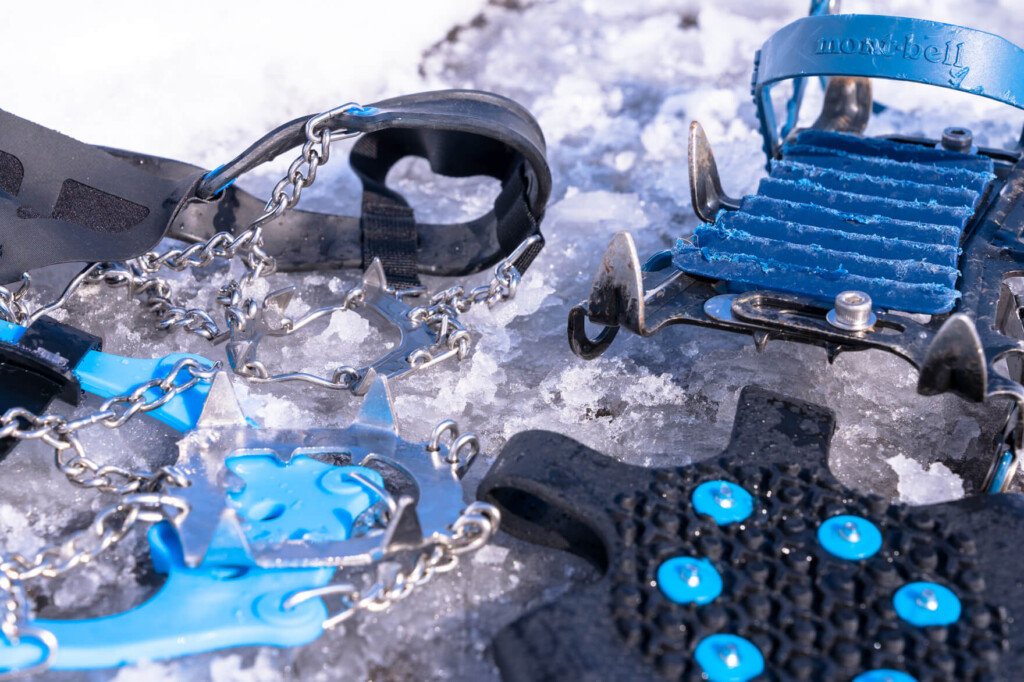
The size, length and shape of the spikes vary depending on the model. Before purchasing, make sure it is suitable for your purpose.
The strength of the grip of a light crampon, in other words, how highly grip the light crampons have and whether they are not slippery depends solely on the length and number of spikes (and the layout pattern).
Of course, it's not that strong enough. Generally, the stronger the traction, the heavier the heavier and heavier. Choose the length and number of spikes for the model you want to choose to suit your needs.
This overlaps somewhat with what I explained in the introduction to the type above, but the longer the spikes, and the more the grip the stronger the grip, but the more the length will have a greater impact than the number of spikes.
For example, Hillsound's Trail Clan Pumplo has 10 spikes about 2-3 cm long, while Trail Clan Pumplo has 18 spikes about 1.5 cm long, but if you use it on more technical trails on winter hiking, Trail Clan Pumplo is definitely more secure. This is because the longer spikes dig deeper and firmly into harder roads, providing a safer grip.
How long spikes do you need?
So, how long should you consider? Spikes come in a variety of sizes, from shorter lengths of about 5 mm to about 2.5 cm long with long teeth.
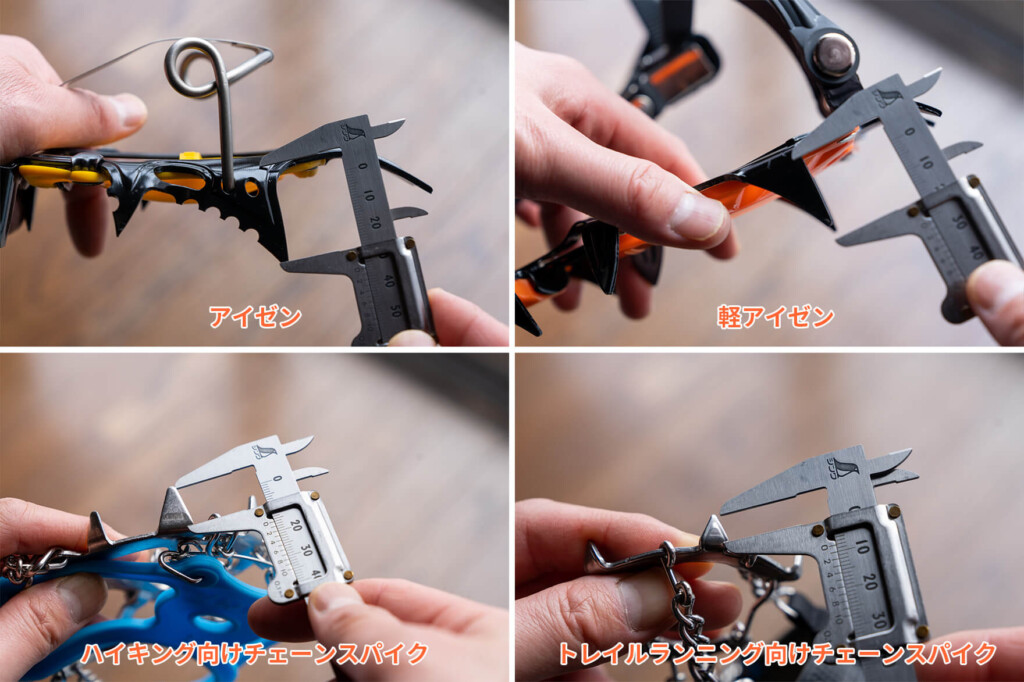
The basic 12-claw crampons (top left) for traversing is also about 3cm long. Other light crampons and chain spikes vary in length depending on the purpose.
A few millimeters... Walking, daily work, running on paved roads
For short spikes, only a few millimeters, they are suitable for walking, running, and snow removal in front of a house when flat paved roads in the city freeze. Large long claws do not stick to paved roads and make them difficult to walk, making them less likely to be optimal.
About 1-2 cm... Hiking and running on trails on frozen ground or tight snowy surfaces
Second, medium length (around 1-2 cm) spikes provide the perfect grip for hiking, running, and backpacking on slightly thicker frozen roads (trails) or some tightly covered snow trails. In addition, this class is not unavailable on paved roads or snowy fields in the city, making it the most versatile class.
More than 2 cm... Harder, deeper snow and ice trails, walking around snowy fields
The last one is a model with long spikes of more than 2 cm. Suitable for walking through harder, deeper snow, ice, snowy fields, etc. as the 6-8-prong traditional light crampons, such as the Montbell Snow Spikes 6 Quick Fit the Hillsound Trail Clan Pumplo , provide excellent grip when climbing or crossing up and downhill snowy or ice surfaces.
However, this class is for hiking only, and like a full-fledged crampon, there is still a lack of satisfaction when climbing snowy mountains in the harsh winter, such as "there are no more than 12 claws" and "the front claws do not protrude from the front," such as climbing a snowy mountain in the harsh winter of 2,000 meters.
Point 3: Fitting (fit and not easy to slip)
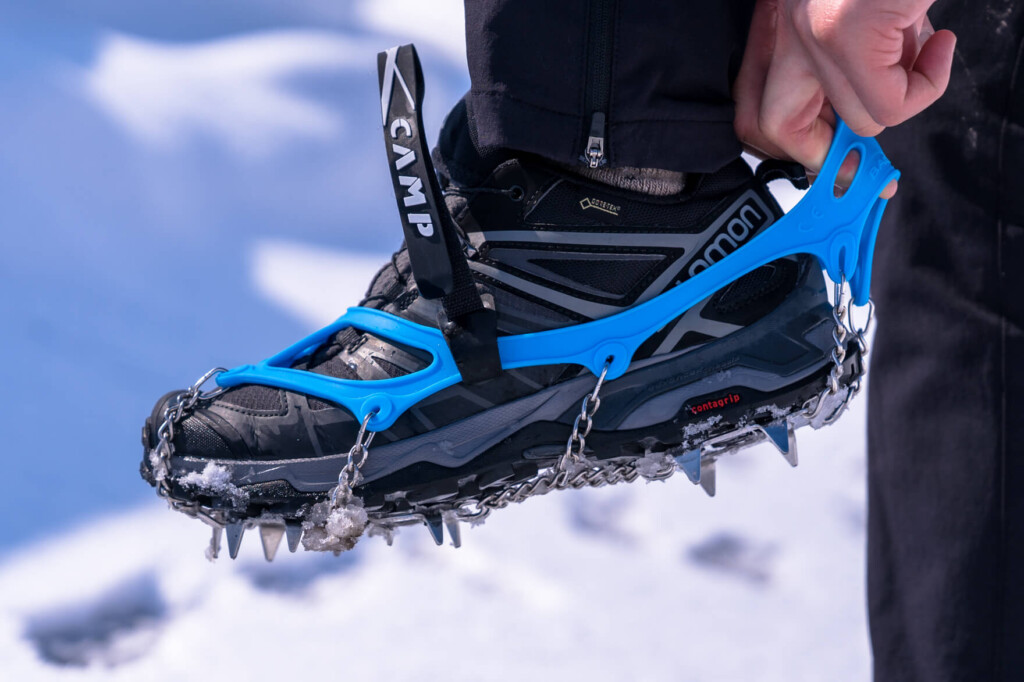
The rubber for fixing varies in ease of attachment and strength depending on the material and shape. To see what's good or bad, it's best to try on and put it on.
Even if you have a light crampon of the right type and level, how safe it can be used depends on the quality of the binding (strap, band, and belt).
Light crampons, which are intended to be worn with relatively soft shoes, such as trail running shoes and hiking shoes, fits even without being a stiff shoe like snowy mountain boots, but because of their flexibility, they have the weakness of being more likely to loosen up while walking than a full-fledged crampon.
For this reason, it is surprisingly a blind spot when choosing light crampons, but it is important to check whether they can be easily put on and taken off, whether they fit perfectly with your shoes, and whether they don't loosen or shift while walking.
The bindings for this light crampon can be roughly divided into "adjustable strap" type and "extendable rubber" type (or hybrid of it).
The former, just like a regular clamp, is a type that allows you to adjust the rubber or plastic strap by hooking it with a buckle, and has the advantage of being able to match shoes of various sizes. On the other hand, since there are more parts, it is handy in terms of ease and weight.
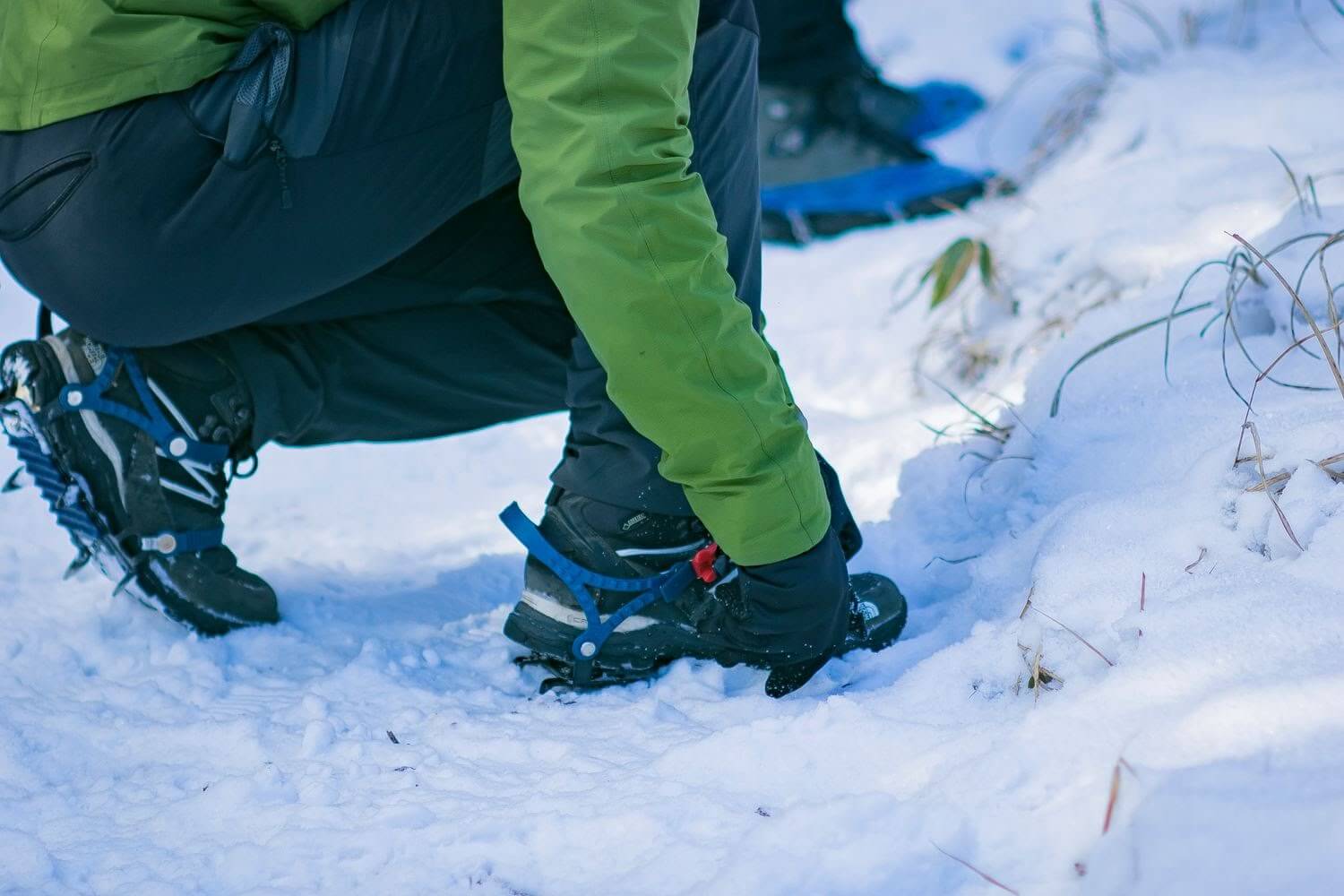
The type that is fixed with a plastic band has a high fixing force, but is less easy to install and flexible.
The latter type is a type that secures the entire foot with a rubber band that covers the outer periphery of the upper and a velcro on the instep. Many coil and spike types use this method, and the advantage is that they combine the flexibility of rubber, lightweight and durable, easy to put on and take off, are difficult to slip, and can accommodate a variety of foot sizes and shapes.

However, these are not small sizes like shoe sizes, but only rough sizes such as S, M, L, and XL, so it's not good at adjusting the sizes in a subtle way. The appropriate size depends on the size of the shoe itself and the preference for cramping, so before purchasing it, you need to check whether it fits your shoes. Of course, trying on the item is the most effective way to get the best fit, but in cases where it's not possible, there are sizing charts on each manufacturer's website.
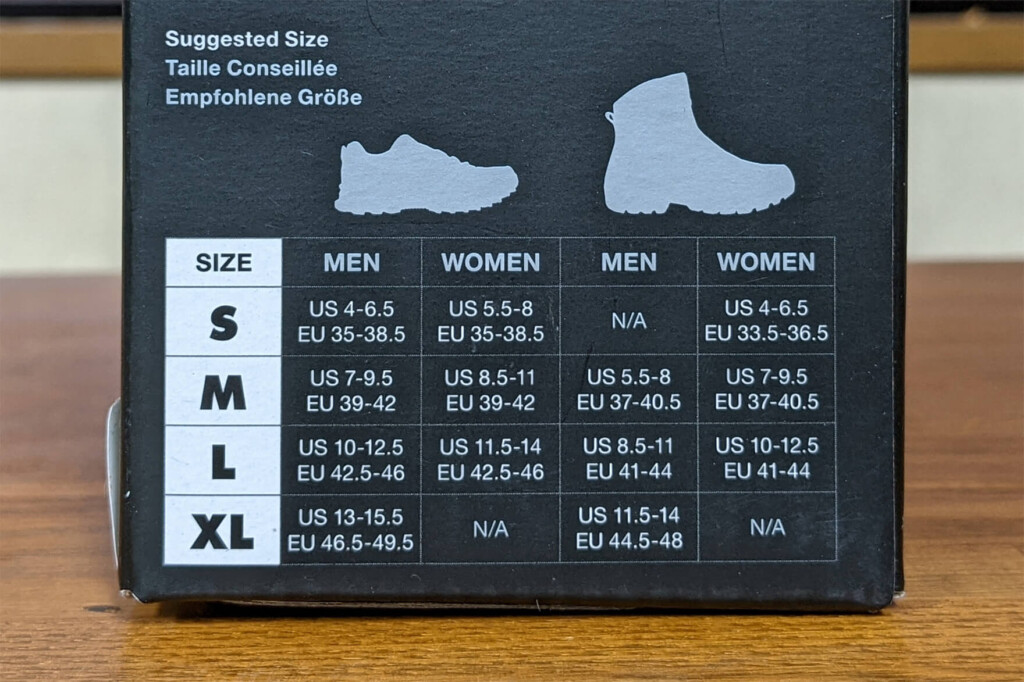
Some manufacturers may display fitting charts for each shoe shape and type. However, to be honest, this is often not very relevant.
What you should be careful about at this time is that light crampons are worn to match the outer periphery of the shoe, so even if you use thin shoes such as sneakers and bulky shoes such as trekking boots, it may not fit well even if they are the same size.
For example, even if you buy a model for a 27cm shoe, if it fits a 27cm trail running shoe, it is often the case that it is smaller when paired with trekking boots. As mentioned above, there are not many manufacturers that show sizing charts for two types of shoes.
What's more, after trying out models from many manufacturers, I realized that the sizing charts published by these manufacturers are not versatile. There are many different types of trekking boots, ranging from thick to thin, so the manufacturer's standards are merely guidelines based on the manufacturer's research. Be especially careful if you have feet around the boundary between sizes such as S and M, M and L. I, who is 27cm tall, have cried quite a bit about this.
Point 4: Weight and Portability

From simple designs to products designed to withstand deep ice and snow, light crampons vary greatly in weight and compactness depending on the purpose of use. It's better to be light and compact, but even if you're so focused on this, you'll end up not being able to perform well.
Of the gears we investigated this time, the lightest model is only about 100 grams, while the heaviest one is 667 grams, which is comparable to a full-fledged crampon. Of course, you should choose the type depending on the purpose, but if it is generally used for everyday use and running in the city, the 100 gram range is the level of use for hiking in frozen or thin snowy mountains, I think a model with a lightness and performance is just right. Models that exceed 500 grams are generally used to walk through alpine mountains with remaining snow, steep glaciers and snowy fields rather than low mountain hikes. It is also important to consider the balance before purchasing, as weight is usually sacrificed to durability.
Similarly, compactness is closely related to weight, and although portable light crampons can withstand city and running, most models are difficult to use in deep ice and snow, so be sure to avoid making the right weight or size for your location and purpose.
Point 5: Durability
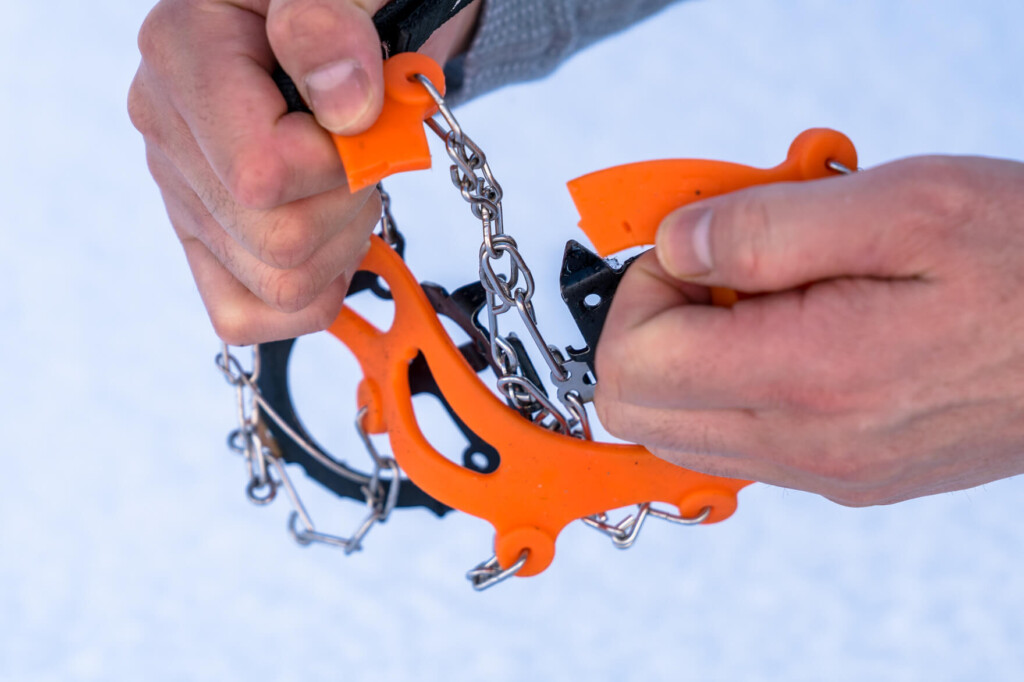
Rubber is easy to use and although it is given a certain consideration for low temperatures and durability, if you pull it forcibly and try to fit a large size that is outside the range, it may break easily.
Light crampons are designed to withstand harsh winter weather and conditions, so most of them can be considered durable against temperatures and strong forces, but there is a significant difference between everyday and mountain climbing.
It's made to be strong, but if you pull it too hard, it can break.
For example, everyday thin rubber spikes have often been pulled too hard after a few uses and ripped quickly, but hiking chain spikes (unless you pulled too hard to fit boots larger than the size) can withstand trail use for years without any problems. The photo above is from my third year of using it, when I tried to force it to fit on a boot that was clearly larger, and the rubber, which had not been seen before, broke easily.
Be careful of rust!
In addition, since the spikes of light crampons are basically made of steel, care after use is also important to make them last longer. To prevent early rust, we recommend wiping it with a towel and drying the spikes after every use. If you walk on a road that contains snow-scavenging agents such as calcium chloride, rinse with warm water and wipe off any remaining salt and residue along the spikes and chains.
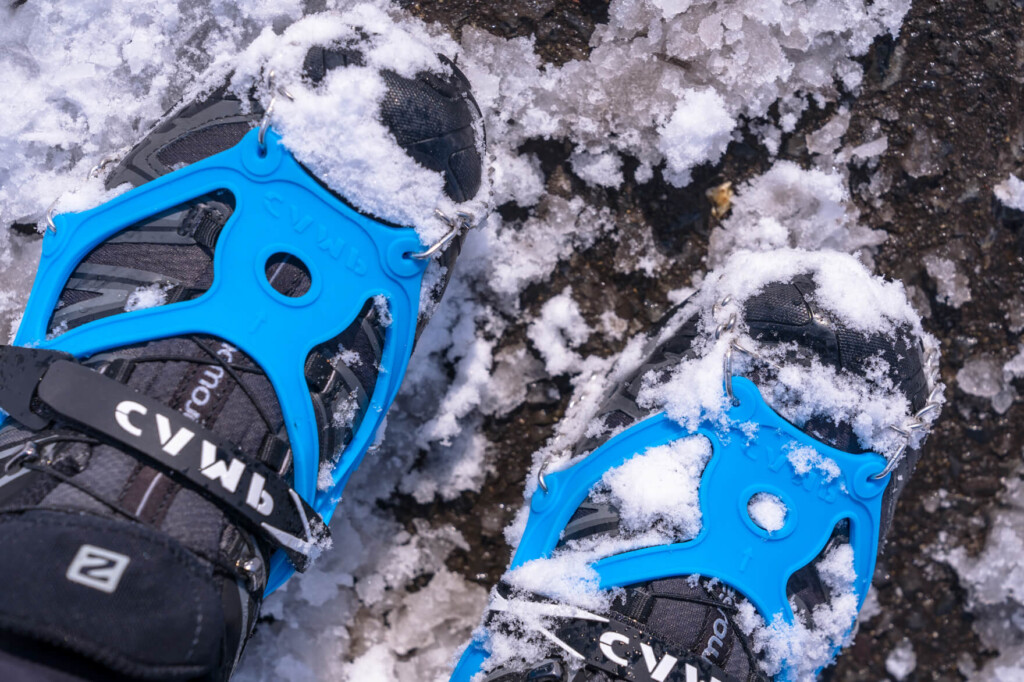
After use, dry thoroughly to avoid rusting. It's the best if it's rust-resistant, such as stainless steel.
When it comes to storage, most snow grips come with a special case for storing when not in use. This is useful when packing in packs mid-hikes and protecting them when storing in the summer.
Summary: The world of light crampons is surprisingly deep. Next time we'll introduce some recommended models
There have long been so-called "simple crampons" with 6, 8, and 10-pronged nails, but at that time, I honestly didn't feel the point of using them. The reason is that I already had 12-pronged crampons, and in most cases that was enough. , when I first bought and tried out the CAMP Ice Master a few years ago Since then, the number of times they have been dispatched in a year has certainly been higher than regular crampons, and during the winter, they are always ready in the car's cargo space just in case.
After doing some research this time, I found that there are more models than I thought are finely optimized for a variety of activities by subtle differentiation of light crampons. It's the same with any tool, but it goes without saying that choosing the right light crampons for the situation, such as activities, time, and location, is important to make your winter day safe and comfortable. So next time, I'll take this into consideration and introduce some of the light crampons I recommend depending on the scene and purpose, so please look forward to it.

